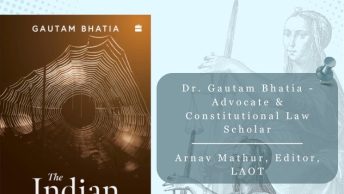The Making of S295, IPC
Neeti Nair, who teaches history at Virginia, has a superb piece in the Indian Economic & Social History Review on the making of Section 295A of the Indian Penal Code, a provision recently in much news because of the Doniger controversy. The entire article is available here. A piece in the Hindu today covers the same topic with passages that are eerily similar to Nair’s piece; available here.






Thanks for this astute observation, Madhav. As I noted in a letter to the Vice-Chancellor of Jindal University a few hours ago, I hope this matter will get an appropriate response. It just so happens that the reference to Sir Malcolm Hailey, Punjab's governor, comes from page 320 of my article, the reference to 'scurrilous scribbles' is from page 330, to Lajpat Rai's concerns that the measure was 'retrograde' and protecting 'historical research' are from page 331, to Hari Singh Gour and the law of blasphemy is from page 332, and the quote by B.P. Naidu on this being 'panicky legislation' is from page 335, the long quote from J. Crerar about 'some obscure and scurrilous scribbler writing from some obscure den or pot-house in a bazaar…' is from page 336. The argument too is broadly from my article. There is no acknowledgement from the author of the article in The Hindu.
The other thing i find disturbing about Shiv's response (yes, i have read his response to Neeti) is how conveniently he comes to the conclusion that because data is present in the public domain, there is no room for any copyright protection. Unfortunately, things are not that simple. The classic instance here is headnote protection, guaranteed by the Supreme Court in Eastern Book Company v. Modak. There is no original content in the case of headnotes, there is no discovery through some painstaking research either. All that there is, is originality in selection that meets the minimal level of skill and judgment. How is this relevant to the present debate? It is for the following reason:
Neeti's piece is not a plain agglomeration of the debates that she has come across on 295A. It is a careful selection of some of the points made by some of the personalities who debated the issue. Interestingly, Shiv's para 4 is nothing but the same selection. He has not used all of Neeti's selection but, and here is the rub, he has not added any of his own. This is akin to how manupatra used to verbatim copy SCC headnotes in certain cases and in certain other cases, remove a few but copy most. Jinnah and Lajpat Rai have had a lot more to say on 295A than what Neeti has selected, but unfortunately, Shiv sees only her selections worthy of reproduction in his piece. This is a classic case of copyright infringement.
I would also like to add that copyright infringement can act as a structural check as well, in cases of striking substantial similarity. The kind of infringement where you are smart enough not to lift words from another man’s work but the structure of your work is such that those who compare the two say, aah, one is nothing but the other. Incidentally, copyright law recognizes structural plagiarism too, and it is well settled that literal infringement is not the only kind of infringement possible, even in the case of works of non-fiction. I invoke copyright law here only because it's the highest standard of egregious copying.
I have gone through the two pieces with a fine comb, the way I used to when practicing copyright law in Madras, and this is how it is done. You have to first cull out the portions in the OpEd which are “termed” a rip-off. These in the offending piece are paras 3 and 4 under the heading “Relevant section and scope.” Once we are agreed on this, let us now compare the structure of this with Neeti Nair’s piece.
I start with para 3 of Swaminathan’s piece and compare it with Neeti’s article. The relevant portion of Neeti’s article starts at p. 318 starting with “In the summer of…..”. She then goes on to discuss Rangila Rasul and Rajpal (p.319), and the discussion goes on till p. 321. The Lahore high court verdict and the response of the Muslim community are discussed in sequential fashion, and no one can deny that this is the ideal structure to communicate the build up of events leading to the amendment. This entire discussion is summarized in para 3 of Swaminathan’s piece. This is nothing but a strikingly similar version of pages 318 to 321 of Neeti's piece.
Now I come to para 4 of his piece. Let us start with Neeti’s article at p. 331, with the opening sentence of the para being “To begin with, the Home Minister…..”. She discusses the views of different people in this particular order: Lajpat Rai, then Jinnah, then Hari Singh Gour (including his Delhi Univ. VC connection mentioned by Swaminathan as well) (p.332), Jinnah again (the “honest man” observation) and finally Crerar at p. 336. The only change Swaminathan brings to this order is by putting in B.P.Naidu who is at p.335 between HS Gour and Jinnah. Otherwise, it is the exact same structure abridged. And with the exact same quotes in the otherwise voluminous research material that Neeti had found worth earmarking to put forth her point effectively. No additions, and only a few quotes being left untouched by Swaminathan makes it a glaring case of reliance on the original.
Unless Swaminathan has something better to say, this is what has happened. He has seen Neeti’s piece. He has seen all the research accumulated by one scholar in one article. He does not now need to revisit the sources. He has conveniently taken chunks of her piece and structured this into two paragraphs of his piece without committing literal infringement except where the quotes are those of public figures. This is a strong case of possible copyright infringement and certainly one of plagiarism unless Swaminathan can convincingly show that he went back to the same resource material and found the exact same quotes selected by Neeti to be the ones worthy of handpicking in order to effectively bring forth his argument.